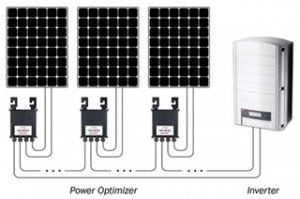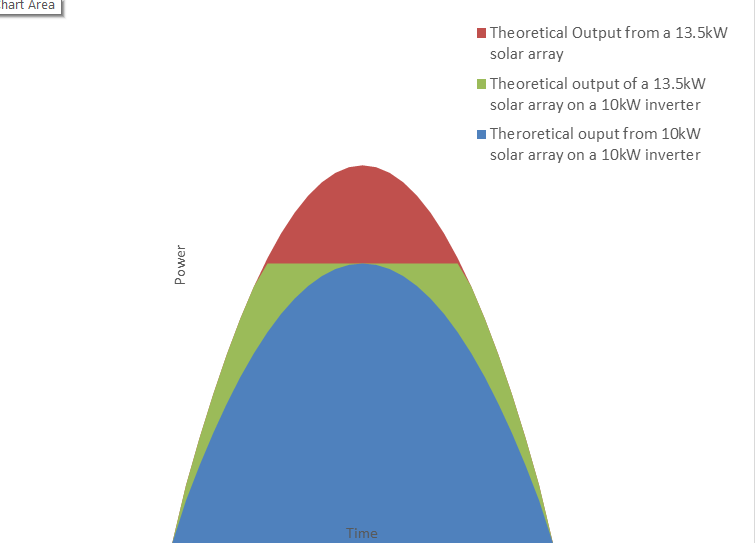One of the most common questions we hear from our more technical customers is “shouldn’t I worry about inverter clipping?” In a word, no. But of course, while I sometimes try to keep it at that, a simple “no” rarely resolves the question.

First, let’s focus on what inverter clipping is; the graph below will help explain. The graph is a plot of an inverter’s Alternating Current (AC) Power production for a single day for a system with a 10,000 watt inverter and 11,880 watts of panels. It was captured on January 12, 2019 when there were no clouds, the sun was bright, and the temperature was in the low 20s – an almost perfect day for solar (this chart is a standard part of the SolarEdge portal). Clipping is when what looks like a nice smooth curve suddenly has its top cut off – and in this case not surprisingly – at the maximum rating of the inverter at 10,000 watts.

And this is where folks get concerned. They’ve got 11,880 watts of panels and the inverter isn’t capable of using all those watts. It just feels wrong.
When does clipping happen?
As in our example, clipping happens on clear cold days when there is lots of sun and the panels are cold. Cold panels produce more power and energy? Why? It’s physics. (I’d go on, but space is limited. You’ll just have to trust me.) But given the need for a cloudless sky, lots of sun, and cold temperatures you’ll quickly figure out that here in New England we don’t get too many such “perfect solar days.” And when they do come, it is typically in the late winter or early spring.
So Why Shouldn’t I Care?
All that said about how infrequently clipping occurs, it isn’t the only reason not to care. After all, it seems reasonable to think that any clipping means you are “losing out” on energy. It just seems to make sense that you should use a bigger inverter, and that is true to a point. But bigger inverters cost more money and thus make the system more expensive. Plus, in much of New England you can lose out on incentives like net metering if your system exceeds certain AC size limits.
But from the purest perspective, isn’t clipping still bad? Again, I’m going to have to say no. To get at an answer, let’s start with a picture of a perfect solar day’s production.

The blue curve is the theoretical power output from a 10kW panel array that has a large (non-clipping) inverter. For simplicity, let’s assume the area under the blue curve is 100 units (BTW, area in this case is Energy or power times time). The red curve is the power output from a larger 13.5kW array that also has a large (non-clippng) inverter. In this case the area under the red curve (meaning all three colors) is 135 units – or 35% larger (matching the extra 3.5 kWs).
Now here’s where it gets interesting. The area of the green curve is the power output from a 13.5kW array, but instead of having a matching inverter its inverter is the 10kW inverter used for the 10kW array (blue curve). What do you think that area is? At first glance you might expect it to be only slightly larger than the blue curve alone, because that’s what your eyes tell you. But like so many optical tricks, the green area plus blue area is actually 125 units or 25% larger than the blue area alone!
Think about that for a minute. Having a matching inverter with the 13.5 kW system gets you 35 more units (on only the most perfect of days), but using the smaller inverter still gets you 25 units more out of those panels. In short, that green “shoulder area” gets you 71% of your “overloaded” panel power without having to upsize (read make more expensive) your inverter.
Not Every Day Is Perfect
In Massachusetts, we can safely assume that every day isn’t a perfect weather day. (As I write this, for example, it’s about 70 degrees and cloudy and it’s been cloudy for the week) so inverter clipping is not an everyday thing. And in fact, for most people the total amount of clipping for a typical year is far less than 2%. And yet, that “overloaded” system still produces that wider production curve than the non-overloaded inverter giving you more power out of the same inverter every day it produces power (note that the green portion is wider than the blue curve everywhere except at zero output) Plus, the inverter manufactures are highly confident that clipping does not harm their equipment. They even tout it in their marketing materials, so you’re not doing any harm in that regard either.
Net? It is best not to worry about clipping and simply focus on generating enough power to cover your usage whenever possible using the best – yet most cost effective – equipment you can buy. As an analogy, you don’t need to rent a tractor trailer truck if a simple pickup will do. Putting more money into a bigger inverter is simply not going to pay you back and thus, clipping just isn’t a bad thing.
(For you math geeks: The curves are parabolas. Parabolas are a near perfect model for solar production on a south-facing, unshaded array. I determined the area under the curves using numerical methods but also had a math wiz friend check my integration using traditional calculus and geometry. A parabola, as it turns out, is a well known conical section with a closed-form integral.)




